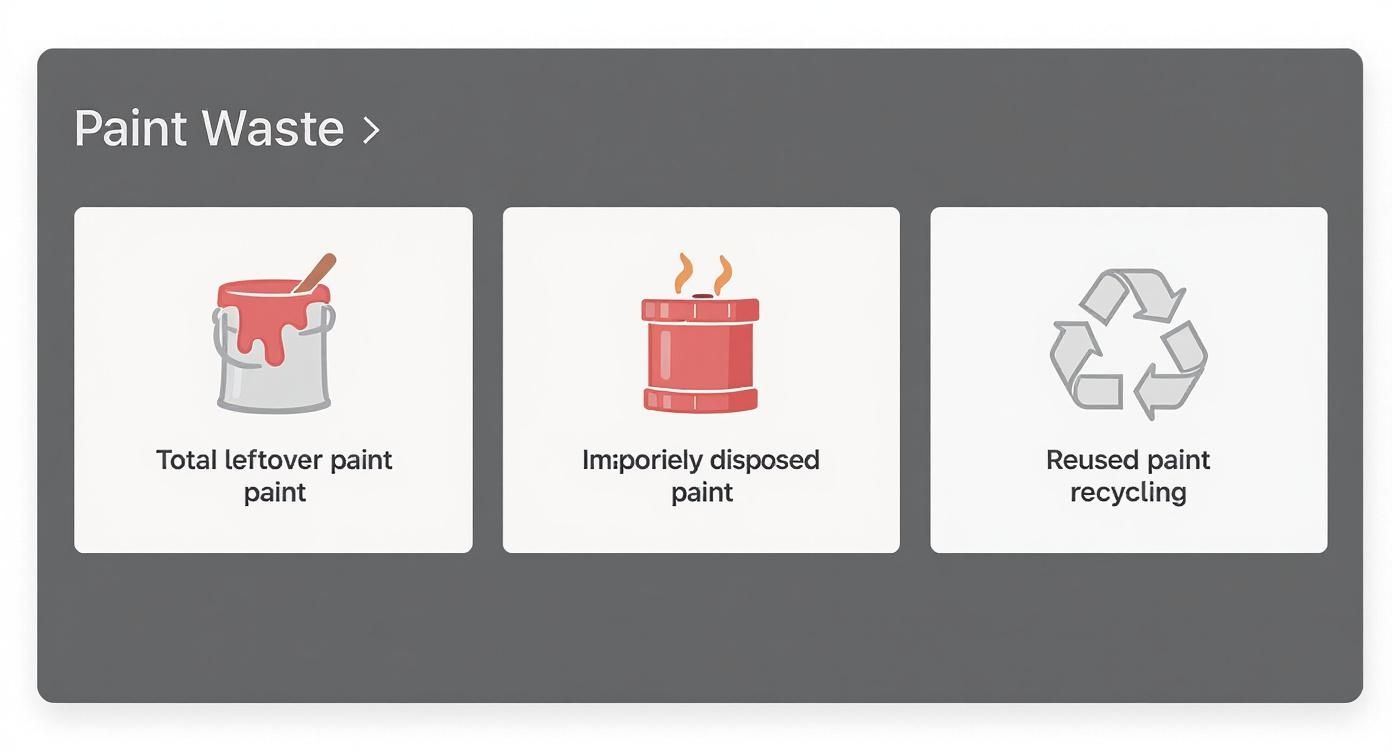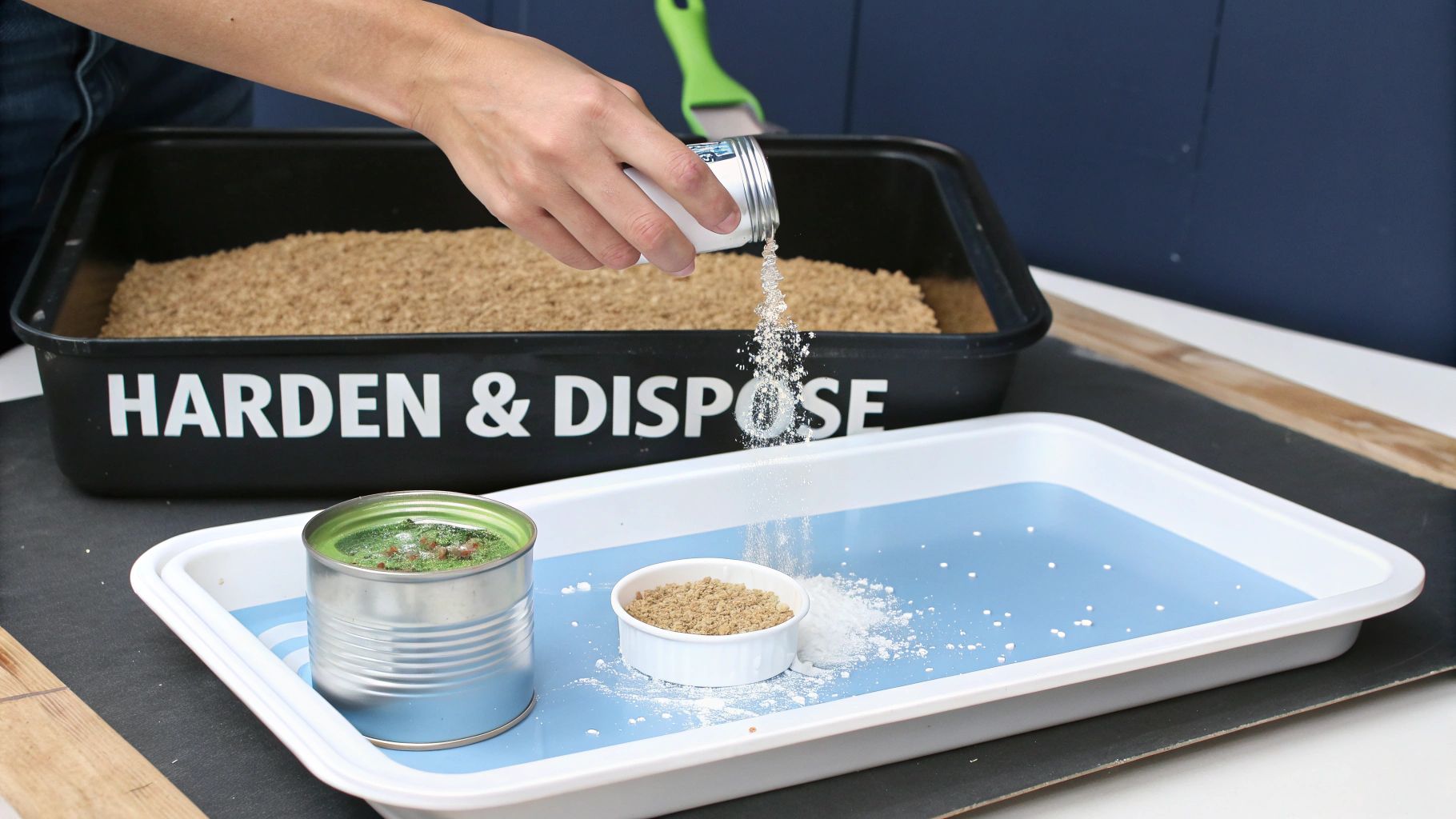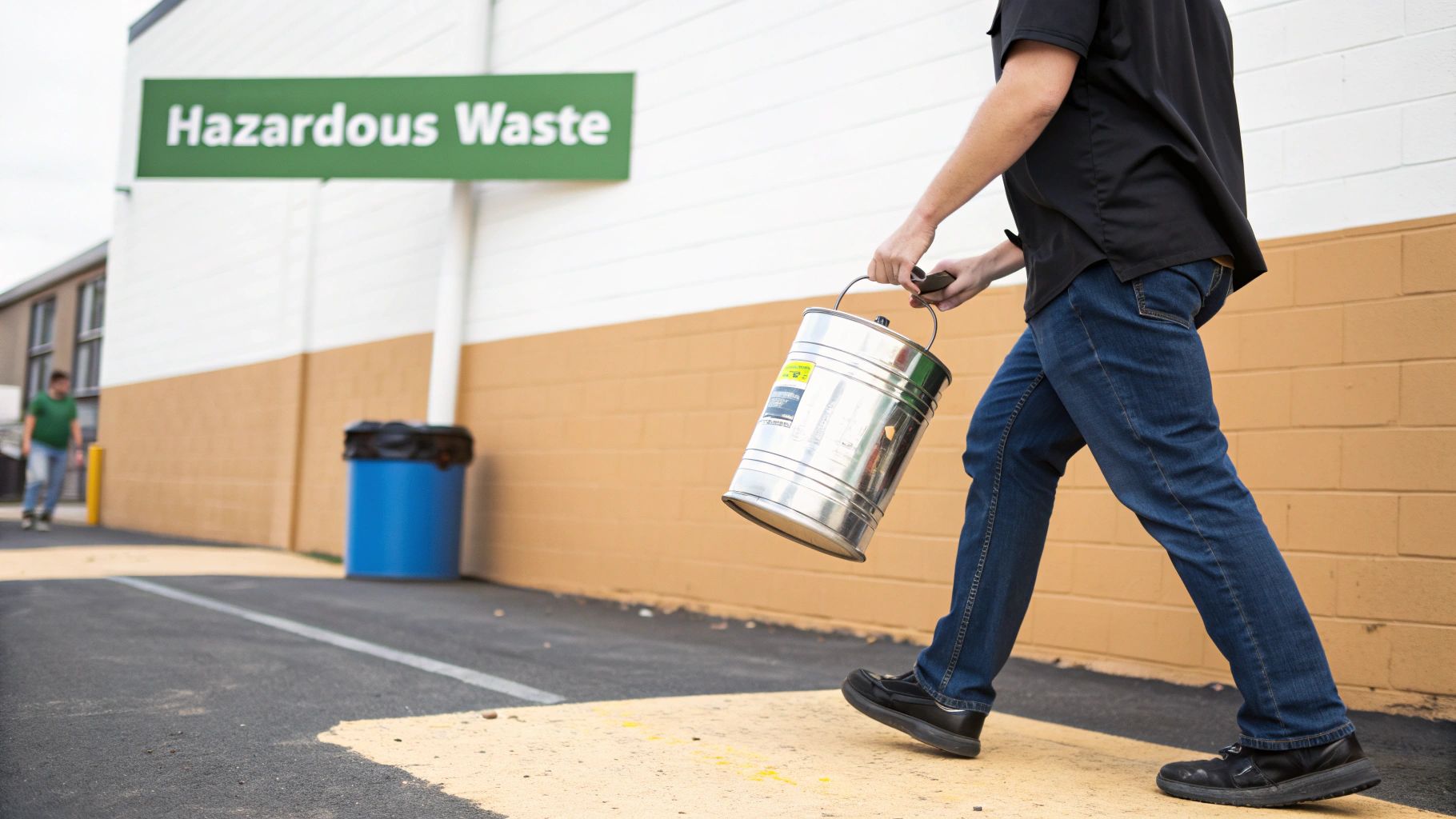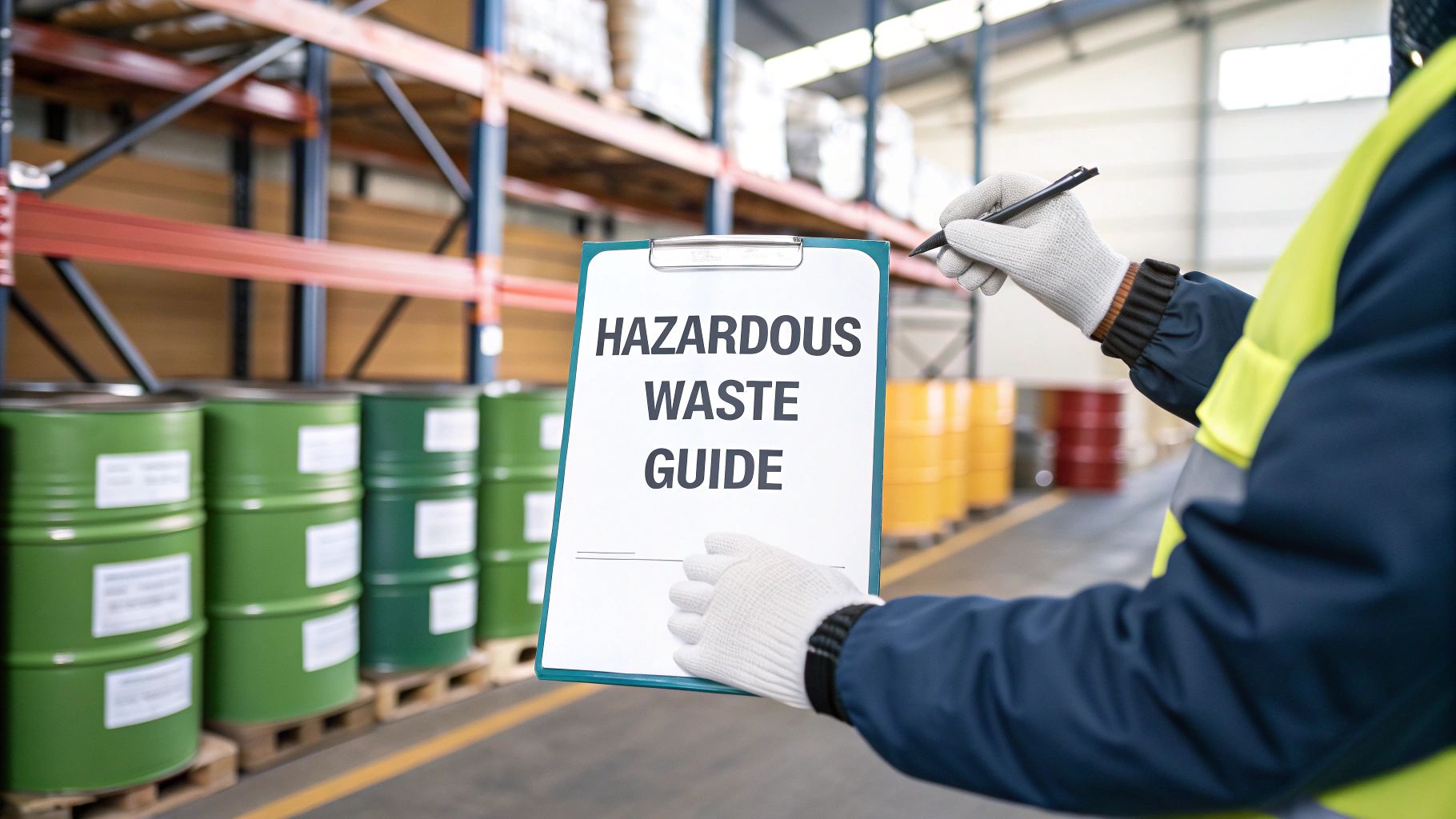How to Dispose of Paint the Right Way
How to Dispose of Paint the Right Way
That half-used tin of paint in the garage is more than just clutter; it’s a surprisingly common household item that needs careful handling when its time is up. Getting rid of paint the wrong way can cause real environmental harm, but the good news is, doing it correctly is pretty straightforward. The first, most important step? Figuring out if your paint is water-based or oil-based.
Why Proper Paint Disposal Matters
It’s easy to look at a single can of leftover paint and think it won’t make much of a difference. But when you multiply that across millions of homes, you start to see the scale of the problem. Disposing of paint properly isn't just about ticking a box for the local council; it's about actively protecting our environment from chemicals that shouldn't be there.
Pouring paint down the drain or chucking it in the general waste bin might seem like the easy option, but it has consequences. Chemicals from oil-based paints can seep into the ground and contaminate the water table. Even water-based paints, while less toxic, can still harm aquatic life if they end up in our rivers and streams. Landfills aren't designed for liquid waste either, and paint can damage their protective liners, leading to more leaks.
The Staggering Scale of Paint Waste
The amount of leftover paint in the UK is genuinely shocking. According to the British Coatings Federation (BCF), we have about 34 million litres of decorative paint leftover each year. That’s a massive 41,000 tonnes of waste. What's worse, recent industry reports show that 98% of this paint is simply sent to landfill, incinerated, or poured down the drain. Only a tiny 2% gets reused or recycled.
When you start to understand the broader consequences, the need for proper disposal becomes even clearer. Exploring resources on the broader environmental impact of improper waste disposal really puts into perspective the risks associated with all kinds of materials, reinforcing why we need to be careful with things like paint.
Your Role in a Sustainable Solution
Every homeowner and tradesperson has a part to play in this. By taking a few extra minutes to identify your paint type and choose the right disposal method, you’re making a direct, positive impact on a healthier environment. This guide is here to give you the practical know-how to handle your paint waste correctly.
Choosing the right disposal method turns a potential pollutant into a managed resource. It’s a small action with a significant positive ripple effect on local ecosystems and community health.
Whether it’s solidifying some leftover emulsion or taking a hazardous gloss paint to a proper facility, your choices really do matter. In the sections below, we’ll walk you through the clear, actionable steps for every type of paint, making sure you can get rid of it safely, legally, and responsibly.
First, Let's Figure Out What Paint You're Dealing With
Before you even think about how to get rid of old paint, you need to know exactly what’s in the tin. This is the single most important first step, and it dictates whether you have a simple job on your hands or something that needs a bit more care. Getting this right from the start saves a massive amount of time, prevents headaches, and makes sure you’re handling everything safely and legally.
In your shed or garage, you'll almost certainly find two main types: water-based and oil-based paints. They might look the same in the can, but their chemical makeup is completely different, which directly impacts how you can dispose of them. And trust me, making the wrong call here isn't a minor slip-up—it can cause environmental problems and put you on the wrong side of your local council's regulations.
This infographic shows just how much leftover paint we generate and how little is currently reused or recycled, highlighting the need for correct disposal.

The numbers don't lie. Most leftover paint ends up being thrown away incorrectly, which is why it's so critical to follow the right process for the specific type you have.
The Simple Tin Test
The good news is you don’t need a chemistry degree to work this out. The answer is almost always printed right on the side of the tin. You just need to know what you’re looking for.
The quickest and most reliable method is to check the clean-up instructions. This is the golden rule of paint identification.
- Water-Based Paint: Look for phrases like "clean brushes with soap and water" or "wash with water". This tells you it's a water-based product, which you probably know as emulsion.
- Oil-Based Paint: The label will mention needing a solvent. Keep an eye out for instructions like "clean with white spirit" or "use mineral spirits". This is your clear signal that it's an oil-based paint, like a traditional gloss or satinwood.
What if the label is ancient, smudged, or has peeled off? Don't panic. Just grab a bit of old paper or cardboard and do a quick test. Dab a small amount of paint on it and try wiping it with a damp cloth. If it comes off easily with just water, it's water-based. If it just smears and needs something like white spirit to shift it, you’ve got oil-based paint.
Paint Type Identification and Disposal Summary
To make it even clearer, here’s a quick-reference table to help you distinguish between the two and understand the basic disposal route for each.
| Characteristic | Water-Based Paint (Emulsion) | Oil-Based Paint (Gloss, Satinwood) |
|---|---|---|
| Common Uses | Interior walls and ceilings | Woodwork, trim, metal, high-moisture areas |
| Clean-up Clue | "Clean with soap and water" | "Clean with white spirit" or "mineral spirits" |
| Drying Process | Dries by water evaporation | Dries by oxidation (chemical reaction) |
| Waste Class | Non-hazardous (when fully dried) | Hazardous Waste |
| Disposal Route | Can be solidified and placed in household rubbish (in small amounts) | Must be taken to a licensed HWRC for hazardous disposal |
This table should be your go-to guide if you're ever in doubt. Getting this right is the foundation for responsible paint disposal.
Why This Distinction Is So Important
Working out what type of paint you have isn't just a technicality; it's the dividing line between simple disposal and hazardous waste management. This single piece of information dictates every single step that follows.
Water-based (emulsion) paints are what most of us use for our interior walls and ceilings. Once they are completely dry and hard, they are considered non-hazardous. This means that for small quantities, you can often prepare them for disposal with your regular household rubbish, but only after you’ve solidified the paint first. We’ll walk you through exactly how to do that later on.
Oil-based and solvent-based paints, on the other hand, contain chemicals called volatile organic compounds (VOCs). These make them officially classified as hazardous waste.
These paints must never be poured down the drain or thrown in your general waste bin, even if they seem dry. Their chemical components can contaminate soil and water, and they absolutely require specialist handling.
Because they're hazardous, they have to go to a designated facility that can process them safely. Your local Household Waste Recycling Centre (HWRC) will have a specific area for hazardous materials just for things like oil-based paints. Understanding this key difference is everything when it comes to getting rid of paint responsibly and protecting your local environment. Nail the identification first, and the rest becomes much more straightforward.
Disposing of Water-Based Emulsion Paint

So, you've checked the tin and confirmed you're working with water-based emulsion. Great news. This is the stuff most of us have in our homes for walls and ceilings, and getting rid of the leftovers is far more straightforward than dealing with its oil-based cousins.
The golden rule here is simple: turn the liquid paint into a solid block before it goes anywhere near your household bin.
Whatever you do, never pour leftover emulsion down the sink, into a drain, or onto the garden. Just because it's "water-based" doesn't mean it's harmless. It’s packed with polymers and pigments designed to stick, and they'll do just that inside your pipes, leading to some seriously expensive blockages. In the environment, these same ingredients can cause real damage to aquatic life.
Of course, the most eco-friendly approach is to avoid having leftovers in the first place. A bit of planning can save a lot of hassle, so try to buy only what you need. If you do end up with a small amount, think about using it for touch-ups or a small craft project—painting a plant pot or a picture frame is a great way to use up the dregs.
The Harden and Dispose Method
For those last bits of emulsion that can't be used, the ‘harden and dispose’ method is the way to go. It's the standard advice from most UK councils. The aim is to dry the paint out completely until it’s a solid puck that can’t spill or leak. Once it's solid, it’s no longer classed as liquid waste and can be safely thrown out with your general rubbish.
You’ve got a few options for this, depending on how much paint is left and what you have lying around.
-
Air-Drying for Tiny Amounts: If there’s just a thin layer left in the bottom of the tin (we're talking less than an inch), simply air-drying it will do the trick. Take the lid off and leave the tin somewhere well-ventilated, dry, and safely away from kids and pets—a secure shed or garage is perfect. It might take a few days or even weeks, but the water will eventually evaporate, leaving a solid film behind.
-
Mixing in Absorbent Materials: For anything more than a smear, you’ll need to add something to soak it all up. This will create a thick, solid mass much quicker than air-drying alone. Common household materials work perfectly: think sawdust, soil, sand, or even cat litter. Just pour your chosen material into the tin, give it a thorough stir until all the paint is absorbed and it’s no longer liquid, then leave it to set hard.
Pro Tip: When you're solidifying paint, don't just dump a load of cat litter or sawdust in at once. Add a bit at a time and stir it in thoroughly. Keep adding more until you get a stiff, unspillable consistency. This makes sure every last bit of paint solidifies properly.
Using a Dedicated Paint Hardener
If you'd rather use a purpose-built solution that gets the job done fast, you can buy a commercial paint hardener. These are powdered crystals that you stir into the paint. They react with the water, causing it to solidify in a matter of hours. You can find them in most hardware and decorating shops.
They're incredibly efficient, especially if you have a few tins to get through or just want a guaranteed result without the guesswork. Just follow the instructions on the packet—it usually just involves tipping the powder in and giving it a good stir.
Once the paint is completely solid, regardless of the method you used, it’s ready for disposal. Most councils allow the hardened paint (still in its tin) to be put in your regular household waste bin. For guidance on what to do with the tins themselves, check out our guide on how to dispose of paint tins.
What to Remember for Safe Disposal
Even with water-based paint, a bit of common sense goes a long way. Always stick to these key rules to make sure you’re handling it correctly and responsibly.
- Work in a Ventilated Area: Always harden paint outdoors or in a well-ventilated space like an open garage to avoid breathing in fumes while it dries.
- Keep Away from Children and Pets: The place where you leave paint tins to harden must be secure and out of reach of little hands and paws.
- Check Local Council Rules: While the harden-and-dispose method is widely accepted, it never hurts to quickly check your local council's website. Some areas might have slightly different rules or specific drop-off points.
- Never Mix Paint Types: Don't be tempted to mix water-based and oil-based paints together. This just creates a hazardous cocktail that can’t go in your household waste and is much harder to dispose of.
Managing Oil-Based and Solvent-Based Paint

When you're dealing with oil-based or solvent-based paints, the rules of the game change entirely. These aren't like emulsions that can be simply dried out and tossed in the bin. They are officially classified as hazardous waste, a label that means they require special, careful handling.
The key takeaway here is you absolutely cannot put these paints in your household rubbish, pour them down the drain, or try to harden them with cat litter. The volatile organic compounds (VOCs) and other chemicals they contain are potent pollutants that can contaminate soil, harm groundwater, and pose a real risk to wildlife and human health.
It's also crucial to be aware of the specific rules around these materials. For a detailed breakdown, it's worth checking a flammable liquids placard guide.
Your Local HWRC Is The Answer
So, what’s the correct way to get rid of paint that’s considered hazardous? The answer is your local Household Waste Recycling Centre (HWRC), often just called ‘the tip’. These facilities are specifically equipped to handle hazardous materials from homes, making sure they are processed safely and in full compliance with environmental laws.
Almost every council-run HWRC has a designated area for hazardous household waste, which includes things like oil-based paints, pesticides, and certain potent cleaning products. This is the only legitimate drop-off point for homeowners looking to get rid of these items responsibly.
Before you load up the car, a quick visit to your local council’s website is a must. Search for the HWRC section and look for details on:
- Accepted Materials: Double-check that they explicitly accept ‘oil-based paint’ or ‘hazardous paint’.
- Container Rules: Some centres might require paint to be in its original, sealed tin.
- Quantity Limits: There could be a limit on how much you can bring in a single visit (e.g., 5 litres).
- Proof of Residence: You will almost certainly need to bring proof that you are a local resident, like a council tax bill or driving licence.
Following these steps isn't just about ticking boxes; it's about ensuring the safety of the staff who handle this waste and preventing environmental contamination. A quick check online can save you a wasted journey.
Giving Usable Paint A Second Life
What if your oil-based paint is still perfectly good, just unwanted? Throwing it away, even correctly, feels like such a waste. This is where community-focused schemes come into their own, providing a fantastic, sustainable alternative.
The most prominent of these is the Community RePaint network. This brilliant initiative collects leftover, usable paint and redistributes it to community groups, charities, and individuals in need. Your half-full tin of gloss could be exactly what a local theatre group needs for their set, or what a family needs to brighten up their new home.
It’s a win-win: your clutter is gone, the paint is saved from becoming waste, and you’ve directly helped your local community. You can easily find your nearest drop-off point by visiting the Community RePaint website. Many HWRCs even have a dedicated collection point for the scheme right on site, making it incredibly convenient.
Why Correct Disposal Is Non-Negotiable
Ultimately, managing these types of paint comes down to a clear legal and environmental responsibility. Understanding the specific hazardous waste disposal regulations is key for both homeowners and businesses to ensure compliance and protect our environment.
For domestic users, the HWRC is your primary route. However, for larger quantities, particularly from commercial activities, a professional collection service isn't just an option—it's a legal requirement.
Drying out the odd tin of leftover emulsion is a great habit for any DIYer. But let’s be realistic—sometimes the job is just too big, too complicated, or too messy to handle yourself. Knowing when to put down the cat litter and pick up the phone is the key to getting rid of paint safely, legally, and without the headache.

While the DIY method works for a couple of half-used tins, it just isn’t practical when you're facing a mountain of them. Trying to manage large amounts of paint on your own can easily lead to a mistake, risking environmental harm and even some hefty fines. This is the point where a professional waste service like The Waste Group stops being a luxury and becomes an absolute necessity.
Large-Scale Renovations and Clearances
Picture this: you've just finished a full-scale renovation. You're not looking at one or two leftover tins; you've got dozens. There's a mix of emulsions, glosses, primers, and maybe some specialist wood treatments, all needing to go. This is the classic scenario for calling in the pros.
A professional collection means we can take all that paint in one go. It saves you countless trips to the local tip, which often has tight daily limits on how much hazardous waste you can bring.
Or, imagine you're clearing out a relative’s old shed. You might find a treasure trove of ancient, unidentifiable paint tins, thinners, and mystery chemicals. You have no idea what’s inside them, and mixing them could be genuinely dangerous.
When you’re dealing with unknown or very old chemicals, professional help is the only safe bet. Our trained teams can identify and sort these materials properly, removing any risk of dodgy chemical reactions or injury.
Navigating Commercial and Trade Waste Rules
If you’re a painter, decorator, or builder, the game changes completely. Any waste from your business is legally classed as commercial waste, and you absolutely cannot take it to your local household recycling centre. Trying to pass it off as domestic waste is illegal and comes with serious penalties.
For anyone in the trades, using a licensed waste carrier isn't just good practice—it's the law. It ensures everything is documented and disposed of correctly, protecting you, your business, and your clients.
- Staying Legal: For every collection, a professional service provides a Waste Transfer Note. This is your legal paperwork proving you’ve disposed of the waste responsibly. You can learn more about why this is so important in our guide on what a Waste Transfer Note is.
- Saving Time: Why waste hours driving to and from disposal sites when you could be on the next job? Scheduled collections let you focus on your work while we handle the waste.
- Safety and Insurance: Licensed carriers are fully insured and trained to manage hazardous materials. It takes the liability right off your shoulders.
When Convenience and Safety Just Make Sense
Sometimes, the decision is simple. It's about convenience and peace of mind. Perhaps you have mobility issues that make lugging heavy paint tins a struggle, or maybe you don't have a car big enough to transport them without making a mess. Your local tip might have awkward opening hours or be miles away.
Hiring a professional service cuts through all that hassle. You book a collection, and we handle the rest. It's a straightforward way to know you've done the right thing for the environment and followed all the rules, without any of the heavy lifting or logistical nightmares. A dedicated collection is your guarantee that the job is done properly.
Common Questions on Paint Disposal
Even with the best plan, you always seem to run into those last-minute questions when it's time to get rid of old paint. We've pulled together the most common queries we hear to give you quick, clear answers. Think of this as your go-to guide for handling those fiddly final details.
Can I Recycle Empty Metal Paint Tins?
Yes, you usually can, but there's a big condition: the tin has to be completely empty and dry. You'll need to scrape out any leftover paint and let that thin film inside dry out fully before it goes into your household metals recycling.
A tiny bit of dried-on paint is generally fine, but any liquid residue or solid lumps means it has to be treated as general waste.
It's always smart to double-check your local council's specific rules. Some might ask you to take the handle off if it's plastic before you pop the tin in your recycling bin.
What Is the Best Way to Get Rid of Very Old Paint?
Found a dusty old tin of paint that's been hiding in the shed for a decade? First thing's first, you need to figure out what you're dealing with. If it's oil-based, it’s classed as hazardous waste and needs to go straight to your local Household Waste Recycling Centre (HWRC), no matter how old it is. If the tin is bulging or looks seriously rusted, don't even try to open it—take it directly to the professionals at the HWRC.
For very old water-based paint, you'll have to see what state it's in. If it’s separated into a watery layer on top with solid lumps at the bottom, it's probably past its best. You can give it a really good stir for a few minutes to see if it comes back together. If it stays lumpy or has a sour, rancid smell, your best bet is to harden it with cat litter or a paint hardener and then dispose of it with your general rubbish.
It's a common mistake to think everyone knows what can and can't be recycled. The reality is, public awareness about specific items like paint tins is still a major issue in the UK.
Research shows that while most of us say we recycle regularly, a surprising amount of recyclable material—including paint tins—still ends up in the general waste bin. This often happens because people simply don't realise that leftover paint can be passed on and that empty containers are recyclable once they're prepped correctly. You can learn more about these habits from the latest Recycling Tracker survey.
This just goes to show why checking your local rules and preparing items properly is so important for making recycling work.
Can I Pour Paint Down the Drain if I Dilute It with Water?
Absolutely not. This is probably the single most important rule of paint disposal. It makes no difference if it's a water-based emulsion or how much water you add—paint is full of polymers, pigments, and other chemicals that are incredibly harmful to rivers and aquatic life.
Pouring it down the drain can cause major blockages in your pipes and seriously mess with the biological processes at wastewater treatment plants. Always solidify water-based paint or take oil-based types to a proper facility. The drain is never, ever an option.
What Should I Do with Paint Thinners and Solvents?
Paint thinners, white spirit, and similar solvents are all classed as hazardous household waste. These chemicals are highly flammable and cause severe damage to the environment. They should never be poured down a drain or thrown in with your regular rubbish.
The only safe and legal way to dispose of them is by taking them to your local HWRC.
- Keep them in their original containers so they're clearly labelled.
- Check that the lids are screwed on tight to prevent any leaks.
- When driving, make sure they are secure in your car and can’t tip over.
Once you get to the recycling centre, the staff will point you to the dedicated drop-off area for hazardous waste where these chemicals can be managed safely.
Is It Okay to Put Hardened Paint in a Skip?
Yes, but you have to play by the rules. Small amounts of fully hardened water-based paint are usually fine to go into a general waste skip. The crucial word here is 'solid'—there can be absolutely no liquid left.
However, you must never put liquid paint of any kind into a skip. The same goes for any hazardous materials, like oil-based paints, solvents, or unidentified chemicals. This is a big deal because it contaminates the entire load of waste and could result in you being fined by the skip hire company. If you've got a large amount of paint to get rid of, especially if it includes hazardous types, a dedicated collection service is the only correct and legally compliant choice.
Facing a garage full of old paint tins or managing waste from a big renovation? Don't let paint disposal become a bigger job than it needs to be. The Waste Group offers professional, compliant, and hassle-free waste collection, including skip hire and hazardous waste management. We make sure your paint is dealt with correctly, saving you time and giving you total peace of mind. Get a quote today and let the experts handle it for you at https://www.thewastegroup.co.uk.

